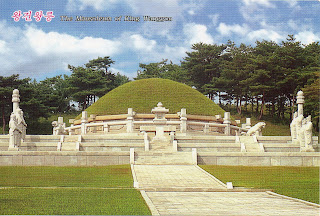Papahānaumokuākea is a vast and isolated linear cluster of small, low lying islands and atolls, with their surrounding ocean, roughly 250 km to the northwest of the main Hawaiian Archipelago and extending over some 1931 km. The area has deep cosmological and traditional significance for living Native Hawaiian culture, as an ancestral environment, as an embodiment of the Hawaiian concept of kinship between people and the natural world, and as the place where it is believed that life originates and to where the spirits return after death. On two of the islands, Nihoa and Makumanamana, there are archaeological remains relating to pre-European settlement and use. Much of the monument is made up of pelagic and deepwater habitats, with notable features such as seamounts and submerged banks, extensive coral reefs and lagoons. It is one of the largest marine protected areas (MPAs) in the world.
fredag den 30. august 2013
Poland - Wieliczka and Bochnia Royal Salt Mines
Bochnia Royal Salt Mines (Poland) is an extension to the Polish Wieliczka Salt Mine, inscribed on the World Heritage List in 1978, which is now to be known as the Wieliczka and Bochnia Royal Salt Mines. The Wieliczka Saltworks Castle used for the management of the property was also added to the site. The rock salt deposit in Wieliczka-Bochnia has been mined since the 13th century and is the oldest of its type in Europe. Spread over several levels, it has 300 km of galleries with underground chapels, storerooms and more. It includes altars and statues sculpted in the salt, making a fascinating pilgrimage into the past of a major industrial undertaking that developed over 700 years.
fredag den 16. august 2013
Korea, Democratic People's Republic of - Historic Monuments and Sites in Kaesong
Situated in Kaesong city, in the south of the country, the site consists of 12 separate components, which together testify to the history and culture of the Koryo Dynasty from the 10th to 14th centuries. The geomantic layout of the former capital city of Kaesong, its palaces, institutions and tomb complex, defensive walls and gates embody the political, cultural, philosophical and spiritual values of a crucial era in the region’s history. The monuments inscribed also include an astronomical and meteorological observatory, two schools (including one dedicated to educating national officials) and commemorative steles. The site testifies to the transition from Buddhism to neo-Confucianism in East Asia and to the assimilation of the cultural spiritual and political values of the states that existed prior to Korea’s unification under the Koryo Dynasty. The integration of Buddhist, Confucian, Taoist and geomantic concepts is manifest in the planning of the site and the architecture of its monuments.
mandag den 12. august 2013
Philippines - Tubbataha Reefs Natural Park
The Tubbataha Reef Marine Park covers 130,028 ha, including the North and South Reefs. It is a unique example of an atoll reef with a very high density of marine species; the North Islet serving as a nesting site for birds and marine turtles. The site is an excellent example of a pristine coral reef with a spectacular 100-m perpendicular wall, extensive lagoons and two coral islands.
onsdag den 7. august 2013
Zambia - Mosi-oa-Tunya / Victoria Falls
These are among the most spectacular waterfalls in the world. The Zambezi River, which is more than 2 km wide at this point, plunges noisily down a series of basalt gorges and raises an iridescent mist that can be seen more than 20 km away.
tirsdag den 6. august 2013
Sweden - Decorated Farmhouses of Hälsingland
Seven timber houses are listed in this site located in the east of Sweden, representing the zenith of a regional timber building tradition that dates back to the Middle Ages. They reflect the prosperity of independent farmers who in the 19th century used their wealth to build substantial new homes with elaborately decorated ancillary houses or suites of rooms reserved for festivities. The paintings represent a fusion of folk art with the styles favoured by the landed gentry of the time, including Baroque and Rococo. Decorated by painters, including known and unknown itinerant artists, the listed properties represent the final flowering of a long cultural tradition.
Järvsö
Abonner på:
Opslag (Atom)





